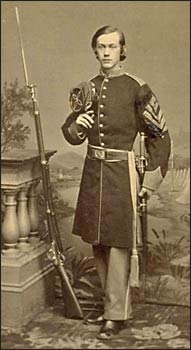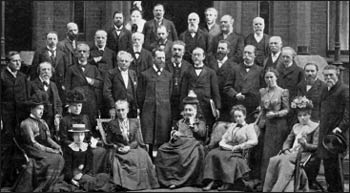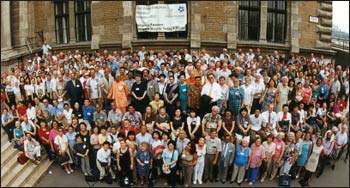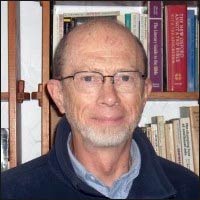By Marcus Braybrooke
THE INTERNATIONAL ASSOCIATION FOR RELIGIOUS FREEDOM – A PROFILE
The first Congress of the International Association for Religious Freedom (IARF) that I attended was in 1981 at Noordwijkerhout in Holland. Almost as soon as I arrived, a German theologian came up to me and said “You must be a Trinitarian. Good that makes three of us.” It was a reminder of the enormous contribution that Unitarians have made to IARF and still do. Yet from its early days IARF has welcomed members of all world religions, who have played an ever-increasing part in all its activities. IARF’s secretariat is now based in Japan.

As a young man, Charles Wendte served as a drill sergeant during the Civil War. Photo: Harvard Square LibraryThe prime mover was Charles Wendte, a Unitarian minister, whose church in Chicago after the great fire of 1871 became a center of relief work. A lasting memory of helping the hungry was of a rabbi carving a joint of bacon held by a Catholic priest. At college, Wendte, already a keen member of the Free Religious Association of America, had read about the Free Protestant Union, which had just been formed in Europe. He was determined to build links between the two bodies and already by 1890 he had made five journeys to Europe.
Thanks to these contacts and those made at the 1893 World Parliament of Religions, 2,000 attended the International Council of Unitarian and Other Liberal Religious Thinkers. Rev. Wendte’s help inspired 770 from 21 different religious groups and 15 countries – including B. C. Ghosh ofthe Indian Brahmo Samaj, to become members of the Council. (Sadly, Z. Toyosaki, representing Japanese liberal religious groups, arrived too late.) They gathered in London in 1901, the founding meeting of the International Council of Unitarian and Other Liberal Religious Thinkers.

Following the 1893 World Parliament of Religions, the 1901 gathering of “Unitarian and Other Liberal Religious Thinkers” marked the first of thousands of interfaith conferences held since then. Photo: IARFThe Council’s aim was to bring together “those striving to unite Pure Religion and Perfect Liberty.” ‘Freedom’ in the IARF name, at this stage, meant ‘Free Religion,’ in contrast to the ‘dogmatism’ of main-line churches. The first president was the eminent scholar of comparative religion Joseph Estlin Carpenter, whose library at Harris Manchester College in Oxford is still a valuable resource for students.
The triennial Congresses held before the First World War were well attended. A few Jews, Muslims, Hindus, and Roman Catholics participated at the 1907 Boston Congress, and subsequently, the name was changed to the International Congress of Free Christians and Other Religious Liberals at the 1910 Berlin Congress, which also included interfaith devotions.
The First World War made international gatherings impossible. It took the IARF, with W. H. Drummond as secretary, a decade to regain momentum. Only 150 people registered for the 1927 Congress in Prague, although over one thousand people attended open sessions. At the next Congress, at Arnhem in 1930, the name was changed to The International Association of Liberal Christianity and Religious Freedom. L. J. van Holk, from Holland, became secretary.
Soon even bigger problems than religious freedom were looming. “Liberal Christianity: the World’s Need” was the theme of the 1937 Oxford Congress. But war once again made any activity impossible. When the IARF secretariat re-opened after the liberation of Holland, it concentrated on relief work. It was not until 1949 that the 13th Congress convened in Amsterdam. Participants affirmed that they stood for “Religion against secularism; Tolerance against bigotry; Liberty against arbitrary authority; Reason against blind emotionalism; Individual responsibility against regimenting states and the Ethics of Jesus not the ethics of the jungle.”

The 31st IARF World Congress in Budapest, Hungary, in 2002. Photo: IARFCongresses in the fifties focussed on world problems and were a chance for members of liberal churches on both sides of the Iron Curtain to meet. By the sixties IARF was actively seeking to work with ‘representatives of world religions’ to address those problems. Jews and Roman Catholics attended the 1966 London Congress, and the imamof the Woking Mosque spoke to participants. Three years later the Japanese Konko Church of Izuo and Rissho Kosei-kai joined and were soon followed by the Tsubaki Grand Shrine.
By the seventies, with Diether Gehrmann as full-time secretary, IARF was becoming world-wide and increasingly inter-religious. The first conference in Africa was held at Lagos in 1973, and study tours to Japan and India, with home visits, have provided good opportunities to make new friends.
In 1984, hosted by Rissho Kosei Kai, the Congress met in Tokyo. With Robert Traer as general secretary, the IARF Congress went to Bangalore in 1993. Most members stayed on to participate in Sarva Dharma Sammelana, a gathering to mark the 100th anniversary of the Parliament of World Religions Centennial.
In 1996 the Won Buddhists hosted a Congress at Iksan, South Korea, and three years later IARF met in Vancouver, where the theme was “Creating an Earth Community.” Recent congresses have been at Budapest in 2002, on “Religious Freedom”; in Kaohsiung, Taiwan in 2006, on “Dignity in Diversity”; and in Kochi, India, in 2010 with the theme “From Conflict to Reconciliation.”

Robert Traer Photo: Dominican UniversityRobert Traer notes that for many years IARF’s main concerns were to strengthen liberal religion and free Christianity. By the end of the twentieth century the focus was to promote religious freedom as a fundamental human right through interfaith co-operation.
The congresses are useful bench marks, but the varied activities of national and local chapters, including the International Association for Liberal Religious Women (IALRW) stand out. IARF’s advocacy workat the U.N. and its partnerships with Religions for Peace, the World Congress of Faiths, and other interfaith and human rights organisations are of equal importance.
Former IARF President Rev. Yukitaka Yammamoto summed up the work of IARF when he wrote, “the activities of IARF are at grass-root level between individuals. We gather to lay bare each other’s true feelings and seriously discuss them. Through this kind of communication we pursue mutual understanding of each other. By spreading our links to many people across borders, our goal is to create a world where everybody can coexist in peace and prosperity.”
At a time when religion is a cause of division in many countries, laying bare our true feelings is costly, but it is the way to reconciliation.
The IARF and the World Congress of Faiths will hold a joint international conference on “Religious Freedom and Responsibility” at Horsham, England, this August 20-23. Click here for details and here to register.

